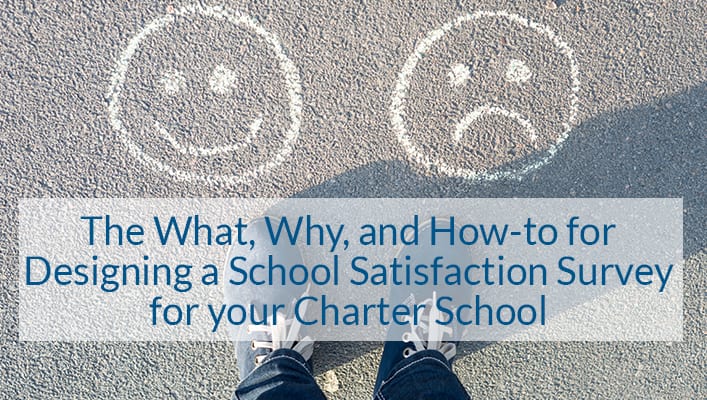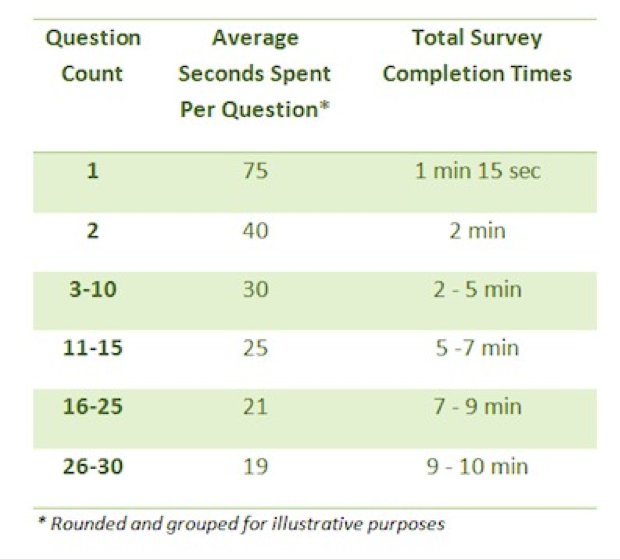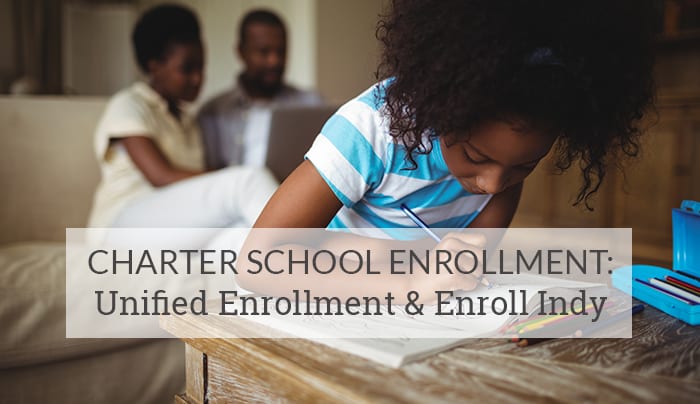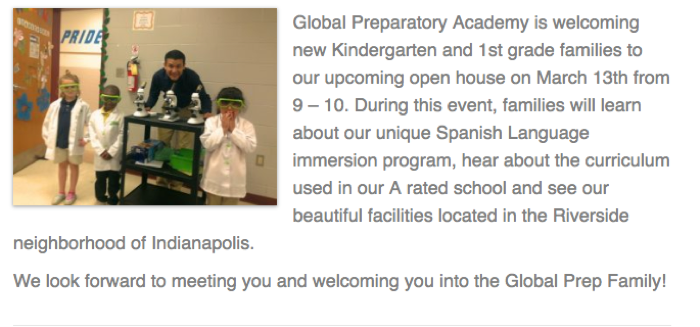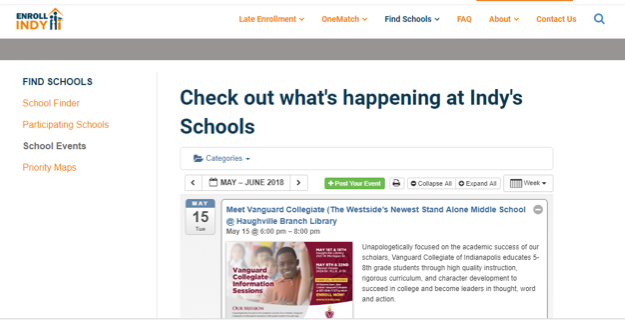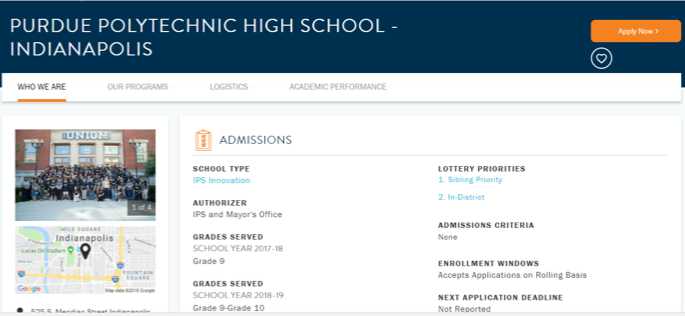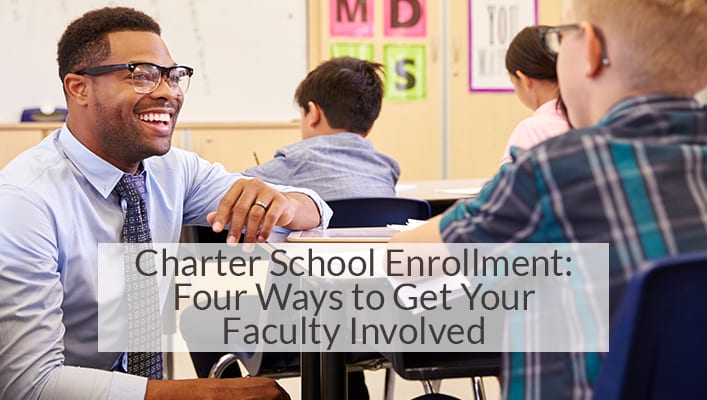 Charter School Enrollment: Four Ways to Get Your Faculty Involved
Charter School Enrollment: Four Ways to Get Your Faculty Involved
As a charter school leader, managing your charter school’s enrollment is a hard and, sometimes, lonely job—and there never seems to be enough time to get everything done.
Often, your colleagues at the school don’t understand the impact of your school’s enrollment numbers on the financial well-being of your school. If they do, they have few opportunities to collaborate or even understand how they can help make a positive difference.
The good news is, it doesn’t have to be a solo job. Far from it. With the right approach, you can encourage your faculty to play a larger role in your charter school enrollment efforts.
Understandably, a teachers’ time can be hard to come by. But because your faculty represents the heart and soul of your school, they can be a huge asset as you are trying to attract (and retain) students.
Here are four easy things you can do to teach your faculty to become more engaged and help bolster your charter school enrollment numbers.
1. Talk – and brag – about your faculty
Parents love to know that the people teaching their children are qualified, smart teachers. They trust that they are going to help that child grow both academically and socially over the next year. But most parents know very little about the teachers at your school.
Therefore, your faculty should be the “stars” of your enrollment marketing efforts. How great would it be the next time you talk to a parent about why those chose your school and they respond by citing some specific and positive attributes of your excellent faculty?
Plus, showcasing your faculty and including them in your marketing efforts is almost a guaranteed way to engage them and have them feel some ownership of attracting students to your school.
Your first step is to make sure that you have compiled bios on all your teachers. These should be a mix of things that establish the quality of your teachers; level of education, where they went to school, types of degrees, years teaching, etc., as well as fun facts, hobbies, favorite experience as a teacher, what inspired them to work in a school, etc.
Your next step is to make sure you have a faculty section on the website where you can publish all of your staff biographies. You’d be surprised how few schools do this. Providing this “inside” information can increase interest in your school because it enables parents who are considering your school to see your strong and varied instructional staff, and it can even provide a competitive edge.
Once you have your staff’s information compiled and, on your website, it’s very easy to use this content to create a series of social media postings. Keeping up with the constant need to post material on social media is challenging for every school. But laying a solid foundation with those bios buys you a lot of content that you can use year after year.
Consider doing a “Teacher Tuesday” or a “Faculty Friday” series of posts where you post the bios on your social media channels. If you have a monthly or weekly newsletter, this would be fantastic content to feature there as well. Celebrating your staff can also create a powerful community feel for your school – your faculty might find common bonds with parents, prospective parents, or even students, over attending the same university or sharing the same hobby.
You will probably find that parents will engage more with these posts and make comments like: “She was an awesome teacher.”, or “We loved Mrs. Smith.”.
Going through this process will also allow you to gather some fun facts about your staff that you can use in your marketing. Things like “50% of the teachers at Inspire Charter School have master’s degrees”, “10 of the teachers at Northside STEM Academy are alumni of our school”, or “We have over 600 years of teaching experience at Science Prep.” These can be little blurbs on twitter or they make a great infographic for your admissions material.
2. Use your instructional staff as subject matter experts
Parents often read or research suggestions on parenting, particularly for specific phases of their kids’ lives. You only need to do a quick search on parenting blogs to realize that parents are constantly seeking information. Your instructional staff are your internal subject matter experts in childhood development and education and can be excellent resources.
Set up a simple editorial calendar by asking each of your staff members to write one to two articles a year that you can use across all of your marketing channels. (These should be roughly 600-1200 words—but let the content determine the appropriate length.)
Here are a few ideas to get you started:
• Should students specialize in one sport or play multiple sports? – Athletic Director / Gym Teacher
• Best educational toys for a third grader – Third Grade Teacher
• The books that every 6th grader should read – Sixth Grade Teacher or Librarian
• How much screen time is too much? – Guidance Counselor
• Signs that your child is ready for kindergarten – Kindergarten Teacher
The options go on and on. Don’t dictate to your staff what they write but give them creative freedom based upon questions that parents are asking about. I’m sure many of your staff would love to offer suggestions and advice based on their expertise. Let them!
Once you have compiled several articles (blog posts), you now have a ton of content that you can use for your charter school marketing efforts. These can be items like lead magnets (articles on your website that are used to identify prospects), social media content or can be used in a weekly/monthly newsletter, just to support parents by providing a valuable resource.
3. Get them involved in your student enrollment
The personal touches in your student enrollment are often going to make big impressions with prospective parents. When a student tours your school (and you’ve collected their contact information), as part of your follow-up process, have one of the teachers – who will be working with that child in the upcoming year – write a short personal note thanking them for coming and describing a little bit about what the next year will look like. This doesn’t have to be a long letter, but it is much more about the thought and the fact that the teacher personally reached out to the prospective parent.
Even better, if the student expressed interest in your language program, art curriculum or STEM offerings, have the teacher from that discipline write the note. This personalized approach based upon what the student is interested in will pay huge dividends in your recruitment efforts.
Many schools have the teacher write a note for the new students entering their classroom over the summer, this idea just take this one step further and expands it to your prospective students.
4. Increase the amount of positive communication from the teacher to the parent
Though this recommendation is primarily designed for your existing students, a strong charter school enrollment program focuses on the retention of students as well as attracting new students.
Parents love to get visibility into how their child is doing in school. Most parents will check grades, but it is the softer and more emotional development milestones that they don’t hear about as often.
Parents will greatly appreciate a short email or better yet a handwritten note from your teachers to parents just saying something like, “I wanted to let you know what a pleasure it is to have Alex in my class. He is such a good helper and is always being a friend to the other kids.” You better believe that note is going to go on the refrigerator at home and maybe even spur positive conversations around the dinner table.
As every parent can attest, as kids get older, it gets harder and harder to draw out what happened at school that day. Having these as conversation starters can have the added bonus of helping to improve the communication between the parent and their child.
Plus, these small notes, help to show to the student that there are adults in his/her life that care about him/her. Establishing that feeling in a child is one of the greatest ways to encourage engagement in school.
Of course, your teachers’ time is understandably limited, so this doesn’t need to be for every student, every week, but try to encourage your staff write these at least quarterly for each student.
In Conclusion
Your faculty can be a “secret weapon” in your charter school enrollment activities. Utilizing their influence and their knowledge can provide an impactful lift to your marketing and recruiting efforts.
It can be difficult to get your staff engaged because they are all busy doing their own job. But helping them understand that sustaining and boosting enrollment provides job security and helps to ensure the financial health of your school, may inspire action in even the most reluctant of staff members.
In addition, these four steps are all fairly small things that shouldn’t take a huge time commitment from any single staff member. Collectively, though, they can have a very positive impact on how both prospective and current parents perceive your school and your school community, ideally resulting in a boost to your charter school enrollment numbers.
 Digital Marketing for Charter Schools: An Actionable Workbook to Help You Achieve Your School’s Goals!
Digital Marketing for Charter Schools: An Actionable Workbook to Help You Achieve Your School’s Goals!
Still scratching your head as to how to go about implementing marketing efforts to support your charter school enrollment efforts? You’re not alone! This free manual will be your go-to guide for all of your school’s digital marketing needs! Download this actionable workbook to help build get your marketing plans started, guide you as you define your audience and key differentiators, choose your tactics, and start to build your campaigns.
